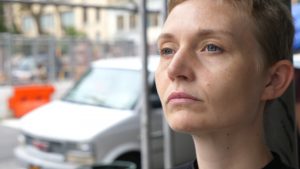Heather Dewey-Hagborg: The Information Artist
Description
Everywhere we go, we leave behind information about ourselves. Artist Heather Dewey-Hagborg is questioning where all that data ends up, and how it might be used against us.
Featured Artists

Heather Dewey-Hagborg is an innovative transdisciplinary artist whose work explores the intersection between art and science and raises questions about the ethics of emerging technologies.
Born in Philadelphia in 1982, Dewey-Hagborg studied information arts at Bennington College in Vermont. She earned a masters in interactive telecommunications at New York University and a PhD in electronic arts at Rensselaer Polytechnic Institute.
For her best-known work, Stranger Visions (2012), Dewey-Hagborg collected anonymous DNA (in hair, gum, or cigarette butts) from public places around New York City and analyzed it to generate 3D-printed life-sized portraits representing what the individuals might look like based on their genome. Her work has been shown at the Philadelphia Museum of Art, PS1 MOMA, and venues across the United States and Asia. It is held in the permanent collections of the Centre Pompidou in Paris, the Victoria and Albert Museum and Wellcome Collection in London, and the New York Historical Society, among others.
She teaches interactive media at NYU Abu Dhabi.
Transcript
Much of Heather Dewey-Hagborg’s work is grounded in DNA—how it’s analyzed, what it can and cannot predict, and how it might someday be used against you. Her most celebrated work to date, Stranger Visions, is a collection of 3D-printed faces, created using anonymous DNA that she gathered in public places around New York City.
Heather Dewey-Hagborg: Your data can always tell so many different stories about you that could be dug into, re-construed, and interpreted to really tell what anyone wants to tell about you—saying “you’re European,” versus “you’re middle-Eastern,” versus “you’re a Northeast African.” I mean, we’re talking about very tiny differences in probabilities or, sort of, the predictive capacity of any of these things. The whole idea is that you could walk up to this face and be confronted, face to face, with the possibility that your DNA could be used in this way—that someone could pick it up and learn all these things about you, construe all of these things about you in whatever way they chose to. And so I’m hoping that, by using art in this way, it makes it visceral, so you can really feel that vulnerability.
Dewey-Hagborg first awakened to that vulnerability as a master’s student. Her thesis project, Spurious, documented a computer dreaming of faces. The research exposed her to cutting edge facial recognition technology and some disturbing realities.
Dewey-Hagborg: Through kind of digging into these algorithms, and coding them myself, and playing around with them, and seeing what they were good at, and also seeing how they failed— and mostly, how they were not as good as they claim to be or aspire to be—I really began thinking about what it meant for these things to be enacted upon people. What it meant for these to be categorizing people, and looking at people, and providing actionable information about people.
AJC: Right. But we have a presumption of innocence in most freethinking societies.
Dewey-Hagborg: I think that depends on a lot of factors. I mean, some people are privileged enough to get afforded that presumption of innocence, but, depending on who you are, and where you’re from, and the color of your skin, you might not be getting such a presumption.
AJC: If we’re going to be cynical about this we’re talking about somebody making money out of us.
Dewey-Hagborg: Yes.
AJC: And that’s the big objection.
Dewey-Hagborg: I mean…
AJC: It’s certainly one of the big objections.
Dewey-Hagborg: It’s certainly one of them, these companies making all this money off of us. If it’s just us selling our individual data, we’re not gonna make much money off of it. Again, it’s not worth that much on it’s own. But are we okay with these companies or institutions profiting off of us without our permission?
But even though our information isn’t valuable to big companies on its own, we are still in danger of being singled out.
Dewey-Hagborg: It has been shown time and time again that you can quite easily re-identify people that have been supposedly anonymized within these studies. So, thinking about medical data, thinking about genomic data, thinking that really any data that’s supposedly been de-identified, with just a few clues, you can usually re-identify people.
And this threat on losing anonymity is the premise of Heather Dewey-Hagborg’s latest venture, what she describes as a post-genomic love story.
Dewey-Hagborg: T3511 is the mostly true story of a bio-hacker’s increasing obsession with an anonymous saliva donor, whose sample they purchased online. And so it follows this story of buying this sample online, profiling it—a la Stranger Visions, in the beginning. So kind of digging into the DNA, but then also culturing this cells, and discovering more and more about this person. And then, in a kind of turnaround, through using direct consumer services like 23andMe, being contacted by that very person.
AJC: Are these your stories, or are they stories you gathered? Or…
Dewey-Hagborg: I mean, it’s drawn on sort of, mostly my own true story, with a bit of speculation in the mix. I mean, that’s generally the way I like to work, is to kind of take the real, and then just push it a little bit to the speculative edge.
And it is from this vantage point—the speculative edge—that Heather Dewey-Hagborg will continue to explore and to create.

